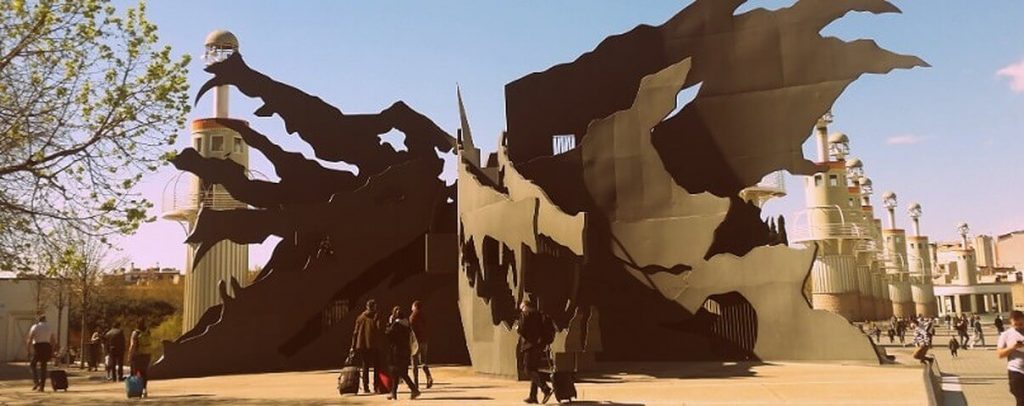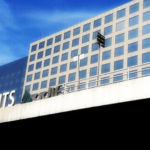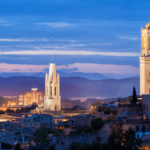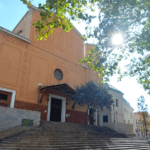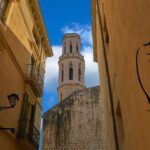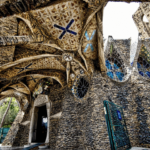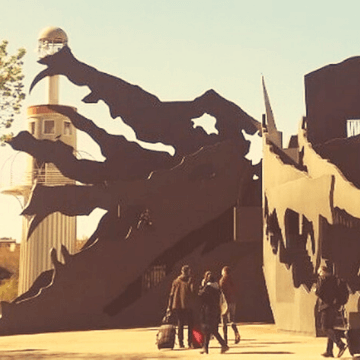
Exploring The Sants Area In Barcelona
WHAT TO SEE IN THE SANTS DISTRICT
Sants in Barcelona is a great example of what locals call “the real Barcelona”. No big monuments or museums to visit there: just buildings where people live, streets and plazas with businesses, offices and schools where daily life happens. The origin of the neighborhood is tied to the Industrial Revolution, when the first factories attracted work hand that needed a job and a place to live.
These are our favorite things to do in Sants-Montjuic:
1
Woman and Bird by Miró
A tall colorful sculpture rises in a corner of Park de l’Escorxador: it’s “Dona i Ocell”, by the Barcelona-born surrealist artist Joan Miró. It’s minimalistic shapes, primary and secondary colors and symbolism are representative of the artist personal style: the moon is the element that resembles a yellow moon on top of the head of the sculpture. And how can we tell it’s a woman? (ALERT: Adult commentary coming): Miró had a special symbol to represent women vaginas, and in this piece it’s the dark hole in one side.
2
Mercat d’Hostafrancs
There’s no better way to feel the pulse of the district than walking down its main artery: Carrer de Sants and Carrer de la Creu Coberta (it’s one same street that changes name at some point). Here locals come on errands and do their shopping on little family-own stores as well as international fashion brands. And in the heart of the avenue, you’ll find this modernist market inaugurated in 1888 as the first World Fair of Barcelona was taking place, in order to provide access to fresh produce to the many workers of the nearby factories.
Until the 1960’s most of the stalls were still made out of wood, and even nowadays you’ll still see a couple of tables set up by local farmers who come every day to sell their own fruit and veggies (the rest of the vendors are retailers). Besides the grocery stalls inside, the outside perimeter of the market is surrounded by other stalls selling clothes and kitchenware.
3
A giant dragon
The area in front of Sants Estació is quite meh… lots of concrete sometimes visited by skaters happy to roll around it, and a park with a lake inspired in a huge factory that once occupied the space – the Parc de l’Espanya Industrial. But one large sculpture stands out: the giant head of a scary dragon built by the Basque artist Andrés Nagel in 1984. I still recall that originally kids were allowed to climb it through hidden stairs and slide down the dragon tongue – a unique giant slide.
Unfortunately, not anymore: its complex maintenance requirements let the city council to limit its access, although from what I’ve heard it’s still possible to climb the stair in the dragon tail to see the views (forgive me if I can’t confirm it: I don’t go that way often and I haven’t been able to find enough evidence online from recent days).
4
Plaça d’Osca
Plazas are the heart of a neighborhood life: there were locals love to hung out, seating on a bench or having a drink in an outdoors cafe. And that’s precisely what Plaça d’Osca means for Sants people, with its lively atmosphere but relaxing pedestrian pace, its cafe tables under the trees (there’s about a dozen bars and cafes here!), and the low buildings that remind you of a village rather than a cosmopolitan city like Barcelona.
Head here on Sunday around noon to see families and groups of friends enjoying their “vermut“ (not just a vermouth drink, but a pre-lunch tapa with a strong socialization accent). Homo Sibaris and La Mestressa are good bars to visit there.
5
Cotxeres de Sants
In 1875 was created a line of trams pulled by mules and horses connecting Sants with La Boqueria market and La Rambla. When in 1904 animal force was substituted by electric energy, the stables where the animals were kept had to be turned into a depot, again refurbished and enlarged in 1924.
This was the building that after the last tramway lines were shut down in the 1960’s the locals claimed for public use: nowadays they are one of the most active cultural and leisure centers in town, run jointly by the Barcelona City Council and a group of local civilian associations. Anything can happen here: from concerts, conferences and workshops, to chess competitions and… even a terror movie festival!
AND BONUS! Would you like to know more about the industrial past of Sants? Here is how it’s been integrated in the district to better serve the locals:
6
Vapor Vell
During the 1800’s Barcelona was one of the first cities in Spain to adhere to the Industrial Revolution, and Sants was one of the areas that assembled a large number of factories. Vapor Vell (the Old Steam Factory) was the first modern textile factory in the area using steam power. Originally called Vapor Güell after its owner, Joan Güell (father of Gaudi’s patron, owner of the famous Park), but the neighbors christened it Old Steam Factory after a newer factory, Espanya Industrial, was open – which they referred to as the New Steam.
The Vapor Vell operated between 1846 and 1891, when Mr. Güell decided to move the factory out of town (it’s the Colònia Güell where Gaudi would later start a church for the workers) to keep his employees away from the violent influence of anarchists that had even murdered one of the managers and tried to kill another one.
After the factory closed, its brick buildings with large windows inspired in the British industrial architecture housed a variety of activities including the pools of a swimming club, until in 2000 thanks to the local vindications, it became a public library. Only the main building of the factory as well as a large smoke pipe have remained from the original complex.
So what about you? Would you like to get lost in the Sants District if you had the time?
Marta
MORE BARCELONA TIPS FOR YOU:
SHARE WITH YOUR TRAVEL MATES
RESEARCHING FOR A TRIP IS TIME-CONSUMING…
Need more inspiration?
Our 100% FREE Barcelona Collection will give you everything you need to organize the trip of your lifetime to Barcelona.
BEST INSIDER TIPS FROM THE PROS!


